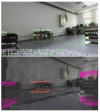Model-Predictive Control for Omnidirectional Mobile Robots in Logistic Environments Based on Object Detection Using CNNs
- PMID: 37299719
- PMCID: PMC10255710
- DOI: 10.3390/s23114992
Model-Predictive Control for Omnidirectional Mobile Robots in Logistic Environments Based on Object Detection Using CNNs
Abstract
Object detection is an essential component of autonomous mobile robotic systems, enabling robots to understand and interact with the environment. Object detection and recognition have made significant progress using convolutional neural networks (CNNs). Widely used in autonomous mobile robot applications, CNNs can quickly identify complicated image patterns, such as objects in a logistic environment. Integration of environment perception algorithms and motion control algorithms is a topic subjected to significant research. On the one hand, this paper presents an object detector to better understand the robot environment and the newly acquired dataset. The model was optimized to run on the mobile platform already on the robot. On the other hand, the paper introduces a model-based predictive controller to guide an omnidirectional robot to a particular position in a logistic environment based on an object map obtained from a custom-trained CNN detector and LIDAR data. Object detection contributes to a safe, optimal, and efficient path for the omnidirectional mobile robot. In a practical scenario, we deploy a custom-trained and optimized CNN model to detect specific objects in the warehouse environment. Then we evaluate, through simulation, a predictive control approach based on the detected objects using CNNs. Results are obtained in object detection using a custom-trained CNN with an in-house acquired data set on a mobile platform and in the optimal control for the omnidirectional mobile robot.
Keywords: computer vision; convolutional neural networks; depth sensing; discretized-time model; navigation; object detection; omnidirectional mobile robots; predictive control algorithm.
Conflict of interest statement
The authors declare no conflict of interest.
Figures










References
-
- Dosoftei C.C., Popovici A.T., Sacaleanu P.R., Gherghel P.M., Budaciu C. Hardware in the Loop Topology for an Omnidirectional Mobile Robot Using Matlab in a Robot Operating System Environment. Symmetry. 2021;13:969. doi: 10.3390/sym13060969. - DOI
-
- Rubio F., Valero F., Llopis-Albert C. A review of mobile robots: Concepts, methods, theoretical framework, and applications. Int. J. Adv. Robot. Syst. 2019;16:1729881419839596. doi: 10.1177/1729881419839596. - DOI
-
- Patle B., Babu L G., Pandey A., Parhi D., Jagadeesh A. A review: On path planning strategies for navigation of mobile robot. Def. Technol. 2019;15:582–606. doi: 10.1016/j.dt.2019.04.011. - DOI
-
- Wang Z., Tian G. Hybrid offline and online task planning for service robot using object-level semantic map and probabilistic inference. Inf. Sci. 2022;593:78–98. doi: 10.1016/j.ins.2022.01.058. - DOI
MeSH terms
LinkOut - more resources
Full Text Sources

